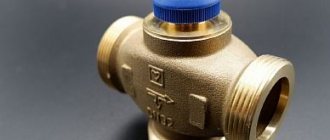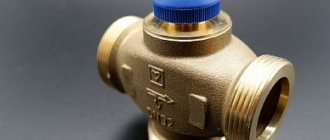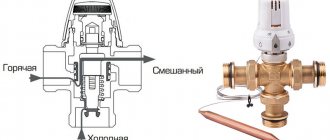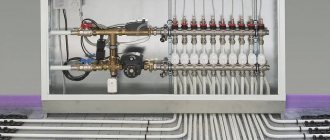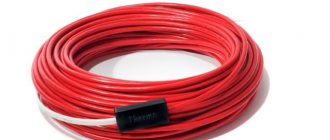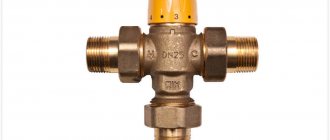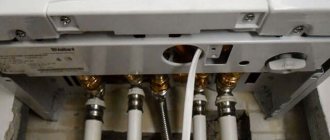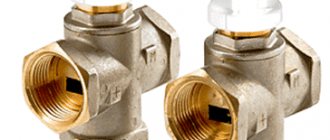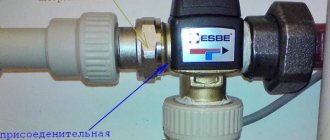The problem of maintaining a comfortable temperature, solved in most apartment buildings by connecting to centralized heating, in a private house sometimes requires the use of complex and expensive technical devices.
The main task in this case is to find the optimal balance between the cost of heating equipment and pipelines, their operating efficiency, design life and operating costs. Three-way valves are designed to simplify temperature regulation, as well as create a comfortable microclimate in individual rooms with minimal losses.
general information
A three-way valve is a device for regulating pipeline networks with a liquid working medium. To explain it in a popular way, after being included in the heating system, the device will perform the function of a well-known mixer tap, the task of which is to switch or mix flows.
Thanks to the ESBE three-way valve, the following results are achieved:
- Redirecting streams from different networks.
- The working fluid is brought to the required temperature by mixing cold and hot fluid.
- Dynamic redirection makes it possible to obtain a stream of stable temperature.
Some useful knowledge
Three-way rotary valve ESBE
The three-way valve is a control device in piping systems with liquid working media. In simple terms, built into the design of the heating network, it will act like a well-known faucet that switches or mixes flows. Installing the valve allows you to solve a number of practical problems:
- Redirection of flows coming from different pipelines.
- Achieving the required temperature of the working fluid by mixing hot and cold flow.
- Achieving a jet with a constant temperature through dynamic redirection.
Difficult? Only at first glance. In order to understand the principle of operation of the device, let's consider its design features.
Design features of the three-way valve ESBE
The three-way valve is adjusted using a rod or ball. In the first case, the adjusting element moves in the vertical direction, in the second - around its axis. This element moves in such a way that the flow of working fluid is not completely blocked: it is only mixed and redirected. The simplest example of such a device is a regular faucet. Its strength is its simple design and low cost; weak – impossibility of obtaining a stable outlet temperature. Despite all their shortcomings, taps are widely used in underfloor heating systems.
If you introduce an electric drive into the design of a conventional faucet, you will be able to significantly increase its functionality: the device will be able to regulate the temperature of the liquid medium automatically. The task of simple balancing valves is to adjust the cross-section to the flow of the working flow.
The device works something like this:
- When the handle is turned halfway, the two flows are evenly mixed, which is ensured by the equality of the inlet valves.
- If you turn the handle all the way, the first valve will be pressed in, causing the liquid flow to be completely blocked.
For commercially available models, the knob turns may differ slightly, which does not in any way affect the principle of operation of the devices.
Which manufacturers can you trust?
The market offers a large selection of shut-off and control valves from reputable brands and unknown companies.
The popularity ratings are dominated by valves from the Swedish brand Esbe, which are distinguished by their reliability and durability. No less high-quality products are produced by the Korean concern Navien.
Three-way fully automatic valves with high precision adjustment are manufactured by Danfoss (Denmark). Products from the American brand Honeywell are distinguished by their simple design and ease of installation. The combination of affordable price and quality is a distinctive feature of Valtec valves.
Main varieties
Three-way valves come in three types:
- Hydraulic.
- Electrically driven.
- Pneumatic.
Electrically driven devices (for example, the ESBE model) differ slightly in their operating principle. The electrical appendage acts here like a regular thermostat: thanks to it, the flows are not only mixed, but also maintained at the desired temperature. During a decrease or increase in temperature, the position of the shut-off valves is automatically changed. As a result, the flow cross-section increases or decreases. At the same time, the cross-section at the inlet of the cold flow changes, which makes it possible to impart a stable temperature to the outlet water. In this case, the three-way valve is completely dispensed with without human control: the control of the equipment falls on automation.
The ESBE valve with electric drive and thermostat can be successfully used in heating systems and hot water supply. Strictly speaking, such a valve can be equipped with any type of pipeline where it is necessary to mix two liquid streams and maintain a stable temperature. Even the highest quality and reliable models of a three-way valve with a thermostat have one common drawback for products of this type: the inlet points through which liquid flows are greatly narrowed. As a consequence, this provokes an increase in hydraulic resistance.
These types of taps are great for water pipes. ESBE valves are often equipped with heated floors, although a special connection diagram is used. Along with the modifications mentioned above, three-way thermostatic valves can be found on sale. Despite the apparent similarity of these devices, their functions differ in many ways. Thermostatic varieties use thermostats with a remote-type sensor. In addition, the operating principle here is also different.
Unlike standard models, thermostatic valves control flow at only one point. The other two inlets are in a permanently open position, with a stable cross-section. When purchasing such a design, it is important to test the second point for narrowness, otherwise difficulties in the operation of the device may arise due to high hydraulic resistance. If such a defect is detected, the problem can be solved by installing a mixing valve in an additional circuit.
Device and principle of operation
The comfort of staying indoors largely depends on the heating system used. The temperature of the water heated floor is controlled using special devices - thermostats.
Many designs of such systems are used, but in most cases they use only a few fundamentally different adjustment methods.
Watch video - setup process
thermostat for heated floors, review and setup
Watch this video on YouTube
But, before considering the operating principle and design of thermostats, you need to understand the object of regulation.
What is heating wiring
Heating a room with a water floor can be done in various ways. One of them is the use of heat from heated water, which acts as a coolant. The transmission is carried out through pipes. Previously, steel pipes were mainly used for heating; now they have been replaced by modern ones made of plastic materials.
The heating circuit can be located along the walls in the form of radiators, or it can be located under the surface of the floor, heating it and the air in the room.
Thermostat for a heating radiator: installation, principle of operation, characteristics, selection criteria.
Hot water or antifreeze is heated in the boiler, after which, using a circulation pump, it is supplied to the heating circuit of the water floor.
Passing through its pipes, the coolant transfers heat into the enclosed surrounding space, heating the surface. The cooled liquid is returned to the boiler system. Depending on the temperature of the “return” in the mixing unit, it is heated or cooled by mixing in colder water from the tank.
In circuits with heated floors, which are connected by a separate circuit, a thermostat is installed for each of them, since they all have their own thermal regime. And the radiator heating circuits heat up to a temperature almost twice as high as for a warm floor.
How does the principle of temperature control work?
The main elements of heating control are servos, temperature sensors and thermostats. This composition of the equipment allows the temperature of the water heated floor to be adjusted steplessly in continuous automatic mode. This happens as follows:
- If a signal about insufficient temperature is received from the temperature sensor, the servo drive opens the valve and more hot water enters the heating circuit.
- When the coolant overheats, the cooled water mixing valve opens, reducing the degree of heating in the circuit.
- However, manual adjustment is also possible by setting the tap to a certain position. But this method requires constant visual monitoring, since the factors on which the heating mode depends change repeatedly during the day. Despite the relative cheapness of such devices, they are very inconvenient to use, since each condition in the room requires intervention in the heating operation.
Adjustment options
Watch video - adjusting the power of the temperature sensor unit
Adjusting the heated floor using a thermostat for water heated floors
Watch this video on YouTube
- The degree of heating of the floor covering. In this case, the heating sensor is installed in close proximity to it. Such a heated floor device is best suited for small rooms and low-power heating circuits that are used only as auxiliary ones, in particular for heated floors.
- Room air temperature - with this control scheme, sensors are used that are mounted directly in the thermostat housing. Correct operation of such a device can only be achieved if all the requirements for insulation of the heated building are met. Otherwise, it is difficult to achieve efficient heating operation - significant energy losses are inevitable. A properly built home with an extensive heating system and thermostat can provide up to 30% resource savings.
- Combined control systems, in which water heated floor temperature sensors are installed both in the heated room and on the mixing unit system. The parameters are adjusted to ensure the most comfortable temperature in the house. Such equipment with a thermostat is used in large rooms. Both sensors or one of them can be used for control.
ESBE tap connection principle
For the vast majority of commercially available three-way devices, one connection diagram is used. For example, you can consider installing an esbe three-way valve. It's best to start with the plumbing system, where mixing valves are most common. The valves in this case prevent the formation of reverse flow. The fact is that cold and hot flows have different pressures, which provokes differences. This may result in backflow. Systems with ESBE valves are completely safe in this regard.
In heating systems, only three areas can be equipped with devices of this type:
- Mixers for the "warm floor" system.
- Pipe entering the boiler. In this way, stabilization of the temperature of the coolant in the incoming pipeline is achieved.
- Outlet pipe to reduce the supply of heated coolant.
Mixing unit
The use of the esbe valve for heated floors has its own specifics. The location of the mixing unit is an additional circuit. Switching with the manifold-distributor is carried out through two points: this allows the coolant at the inlet to constantly circulate. The inlet flow is opened only when there is a need for additional heat.
The mixing unit is connected to the valve and thermostat. You need to understand that a thermostat for a water heated floor allows you to reduce heating costs. Considering the narrowness of all valves at point 2, the pump may encounter problems with insufficient flow. To solve the problem, it is necessary to install a second line that reduces the level of electricity consumption. But such a need does not always arise, because The cross-section of some three-way valves is quite large.
In a situation where the first line has insufficient flow power, the thermostat does not block the passage on the required scale.
To get out of this situation, two options are usually used:
- The second line will narrow.
- A balancing valve is installed.
The second method is considered more effective, because In this case, the flow is adjusted more accurately. There is another scheme for connecting an esbe three-way valve for a heated floor - connecting the pump to the second line: here a balancing valve is not needed. This allows you to equalize the temperature in the inlet and outlet flows.
Installation of a faucet with a thermostat can be carried out in single-circuit systems. Their simplest variation is a warm floor of a small area. In this case, using a large mixing unit is not very practical. A more expedient solution would be to connect a single-circuit heated floor. The installation of a three-way valve with a thermostat is carried out on the return pipe containing the cooled coolant. Thanks to the thermostat, shut-off valves are activated, which increases the cross-section. When the pipe heats up, the temperature sensor detects this and reduces the flow.
Application of valves for heating boilers
Three-way valves for heating boilers deserve special attention. They perform the task of preventing the cooled coolant from entering the pipeline entering the boiler. If this is not done, the pipes will begin to become covered with condensation, and a dangerous temperature difference will arise in the system. This is fraught with deformation of the connecting areas, the most harmless consequence of which will be the appearance of small leaks. If you do not react in time, the system may completely fail.
Particular responsibility should be taken when installing shut-off valves in the piping of a solid fuel boiler, during the operation of which significant temperature changes occur (pro
